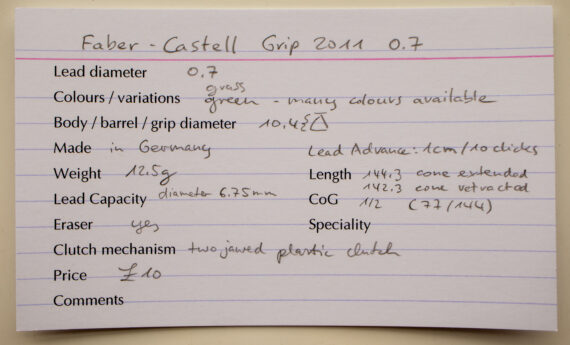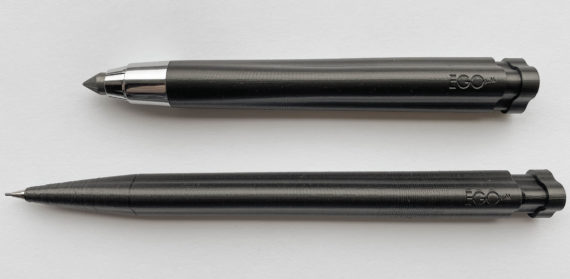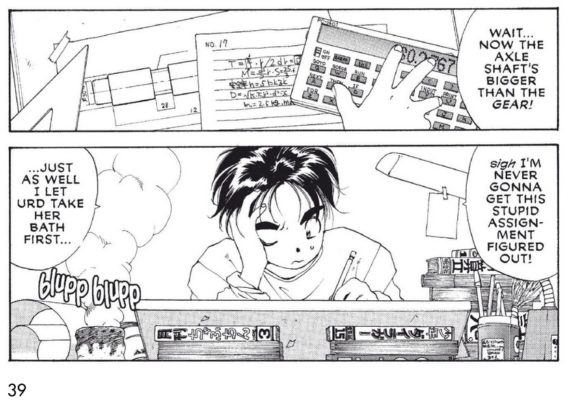Faber-Castell Grip 2011
Today: a look at the Faber-Castell Grip 2011 mechanical pencil. Many years ago I bought a gel pen from the 2011 series. Unfortunately Faber-Castell stopped this gel pen and their gel refills, but there are good alternatives available.
Just like the 2001, the Faber-Castell wood-cased grip pencil, the 2011 has a triangular design with rubbery grip dots and I have read in the past that this series of triangular gip-dotted pens was a big success and saved Faber-Castell from many headaches.

Availability and price
I paid around £10 for my grass green version at PurePens. From what I can tell these are easily available in many European counties and I have seen them in high-street stores in Germany and the UK. In the USA the situation is different: I had a look to see how much they are in the USA, but I only found one place that sells them: Amazon Marketplace – for $18.

Properties
Shape and grip
I have already mentioned the main deign feature: the triangular design with rubbery grip dots.
As always, different people buy a specific pen for different reasons. I bought the 2011 mechanical pencil so that my blue gel pen from this series has company. Other make that decision to help them write without pain: a previous colleague of mine only had items from the Faber-Castell grip line in his office. When I asked him about the reasons behind this he told me that he has carpal tunnel syndrome and that it is easier for him to write with pens from the Grip line. He only used pens from this Faber-Castell series and instead of typing on his keyboard he used dictation software. I don’t know enough about this syndrome to comment further, but it sounds as if Faber-Castell’s grip design can help people to write easier or with less pain.

Weight and the grip diameter to weight ratio
Another speciality of this mechanical pencil is the low weight, probably partly down to the clutch mechanism I will mention later. As seen in the diagram below the 2011 mechanical pencil is very much on the light side.

If you don’t only want a light pencil, but also a big grip diameter then it’s worth looking at the diameter to weight ratio. Here the Grip 2011 is near the top, with a ratio 2.5 times better than some other pencils, like the TWSBI precision. Only the the Staedtler 925-15 is doing better, thanks to its low weight and its big diameter, but it does have a slightly thinner grip diameter. The only pencil in my database with a similar grip diameter to the Grip 2011 is the Caran d’Ache 888 Infinite.

Mechanism
The main disappointment for many seasoned mechanical pencil fans will be the Grip 2011’s clutch mechanism: it is a very simple two-jawed plastic clutch. That’s not a problem, but many mechanical pencileers prefer a brass mechanism. Generally speaking very cheap mechanical pencils, like Staedtler’s $1 graphite 777, will come with plastic clutches, but there are also much more expensive mechanical pencils than the 2011, like the Rhodia ScRipt, that have plastic clutches.

Lead capacity
If you want a mechanical pencil that can hold a lot of leads then the Grip 2011 might also be for you: 0.7 mm leads usually have a diameter of less than 0.7 mm. The inner diameter of the Grip 2011 is 6.75 mm. If you look at the circle packing in a circle problem you will realise that this pencil can hold a huge number of leads.
Conclusion
The clutch will put many potential customers off, but with it’s low wide, its good grip-ability, the above average looks and the reasonable price this pencil will have no issues finding enough customers.
If you want to find out about the fountain pen version have a look at the Well-Appointed Desk’s review.

Faber-Castell Grip 2011 Read More »










